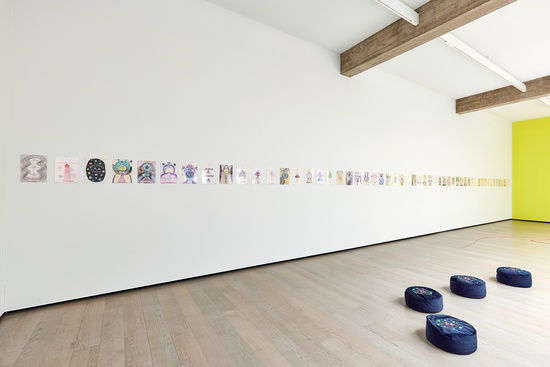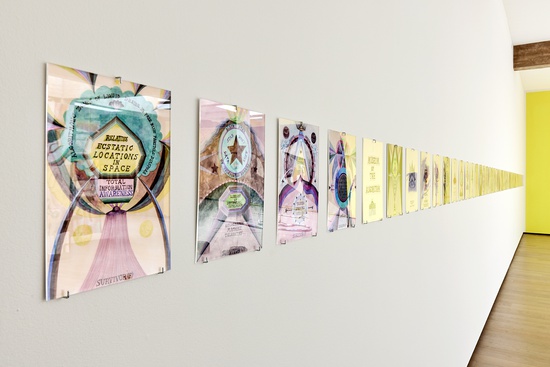5. SURVIVOR (F)
Suzanne Treister
(2016)
A series of images, each on a piece of A4 paper, sing in unison to create an ever-expanding universe of many parts. Unfolding across them are a medley of cosmic apparitions: twinned UFOs float in the sky; laser beams illuminate the unknown; radial clusters pulsate with written messages. “The sky was the colour of the death of the internet,” reads one, in a hand-drawn typeface with a 70s sci-fi flair.
Rendered in a cosmic palette of purples, blues and solar yellows, the powerful imagery of Suzanne Treister’s Survivor (F) is sketched out in pencil and watercolour, giving us a taste of the outsider, the amateur enthusiast creating sketch after sketch in the attic. And yet they are so controlled, so formally and conceptually cohesive as to feel beamed in directly from another planet. They have the aura of the handmade, the hand-drawn, and yet they are copies: reproducible on location, printed to demand, like replicants.
SPACE COLONY. INTERPLANETARY DATA LOVE. HOLOGRAPHIC MACHINE TELEPATHY. LIBRARY OF ARTIFICIAL INTELLIGENCE. In this strange linguistic soup, we find a heady mix of the new age shaman, tech company jargon and the bureaucratic lingo of the government department. Certain words and phrases haunt this neo-universe: algorithm, apocalypse, and curiously, museum. In this cosmic landscape, fantastical museums are erected for Intergalactic Faith, Space Forests, the Technosphere, Machine Telepathy. Shimmering castles floating in (cyber)space, they betray the impulse to reflect, to remember, even in a post-apocalyptic and futuristic world.
That the series is titled “survivor” is of course important: in this post-human landscape, in which only data and stardust remain, there is one sole survivor. We’re not sure if this survivor is human or AI, but the marker “F” might imply that she is female: a lone woman roaming the intergalactic sphere. That most consumer AI takes on a female form (Siri, Alexa) is perhaps not a coincidence here. Those helpful female voices, programmed to listen and respond to our demands, might eventually outlive us all; the data they’ve gathered on our desires and behaviours representing the last form of sentience.
The imaginary objects and poetic fragments in Survivor (F) are not free-floating cosmic visions; they are contained by a precise architecture of circular discs and lozenge forms. References to the erotic frequently surface, suggesting elements of free association, bodily exploration and subconscious desire. But while curvilinear forms crescendo and collide, their libidinal energy feels surveilled and restrained. There’s an Erotic Psychic Sex Universe, but also an Erotic Apocalypse. Instead of a Summer of Love, we get a Summer of Digital Dust. References to new age psychedelia also feel clinical and curtailed, a step removed—like tech companies marketing the ideals of the 60s counterculture back to us as ‘connectivity’ (or their employees using psychedelics to increase productivity).
With each drawing on a sheet of A4—that most standardised surface; the stuff of office inkjet printers—Survivor (F) enters into a modular system. Like a data cloud, it has the potential to keep expanding endlessly, becoming vast and overwhelming, but all while keeping its modest A4 proportions. Each small component is in conversation with one another, operating more like a network of pictures than a monolithic whole. It’s a decentralised communication system, blinking out visionary images and evocative fragments of text, conjuring a distinct and powerful hallucinogenic, post-human, mystical universe. This universe might be in a state of apocalypse, but it’s full of data and poetry, algorithms and orgasms, intelligence systems and spiritual epiphanies.
Text by Rosa Abbott


